If you are planning to start a catering company, you need to have a professional catering business plan. OGS Capital can help you with that; we have a team of professional business personnel and writers who work with us on a daily basis to ensure that clients get customized plans for their business. We strive to make sure that we deliver the final copy of the business plans for catering companies to the customer on time, and this has so far helped us to get referrals and returning customers.
Tips for Succeeding in Writing a Mobile Catering Business Plan
The quality of your catering company business plan will determine whether you will get capital from investors and financial institutions. Hence, it is important to make sure that every detail in the plan is factual and verifiable before presenting it to the investors or banks.
Here are four tips for writing a good business plan for your catering company.
- Carry out an intensive study to understand the hospitality industry
- Convey information about the firm in a professional, cohesive, conscious language
- Layout the various sections clearly using headings and sub-headings
- Proofread the catering business plan to ensure that it is free of any grammatical errors and typos
Adhering to these four tips will help you to come up with business plans for catering companies that you will not be afraid to present and defend when pitching the business idea to the financial institution. Let us proceed and discuss the primary benefits of having an expertly written small catering business plan.
Assist in Decision Making
Every decision that you make will have a positive or negative impact on your catering business. It is, therefore, important to make sure that you consider all the plausible direct and indirect effects that a resolution may have on the enterprise before implementing it to avert regrets.
A good catering company business plan will act as a blueprint that will guide you through the decision-making process. Our team will work hard to make sure that each recommendation made is right for your business. Without a catering company business plan, rest assured that you would be prone to making hasty decisions that could plunge your business in deep financial crisis.
Proper Management of Funds
Unknown to most people is that a catering company business plan does not aim to discuss the business idea only. It goes an extra mile to provide precise details of how the funds will be spent at every stage of the business growth. For instance, it describes the total amount of money that will be used to acquisition equipment. Hence, it will be instrumental in helping you manage your funds correctly. Note that it only takes one financial mistake to compromise the financial stability of the business.
Fosters Transparency and Management
Transparency and proper management are the two primary virtues that set professional catering companies from their counterparts. Poor or lack of transparency results in losses and unnecessary disagreements. All this information will be included in the plan to not only increase your chances of getting funding but also to help you make informed managerial decisions.
Facilitate Setting of Sales Targets
The marketing teams need to have sales goals that they want to achieve after a given duration. Without these goals, they will be operating in a void, and you will also not be able to monitor their performance.
Our marketing professionals will not only help you to come up with a marketing strategy but also provide ideas on how you should set sales targets and objectives.
If you are looking for professional business plans for catering companies that will enable you to enjoy these four benefits, get in touch with us by filling this form. One of our customer care business consultants will get in touch with you to discuss our services in details.
Catering business plan for starting your own building firm
Catering is a business in which you provide food to remote locations to serve people at parties, ceremonies, events, filming sites, and hospitals, etc. The service can sometimes also include the provision of furniture, tables, chairs, utensils, and crockery.
If you are a person who wants to start a business that holds minimum risks, takes a small team and a little investment, then catering is the right choice for you. Besides, another good thing about this business is that it starts yielding profits as soon as it is launched.
What you need to do is just ensure that you manage and market your business plans for catering companies properly. For that purpose, the first step to take is making a business plan for catering. If you need any help regarding how to start a catering business plan, you can have it from here. Here we are providing a business plan for a catering startup, Marlon Caterers.
Executive Summary
2.1 The Business
Marlon Caterers will be a registered and licensed catering business in Atlanta. The business aims to help people celebrate their memorable events with an unforgettable dinner. Moreover, the business will also take care of the needs of patients in hospitals by offering them healthy and nutritious food according to their doctors’ advice.
The business will provide several types of catering such as buffet catering, sit-down catering, hospital catering, corporate catering, and more.
2.2 Management
Management is a very important factor in the catering business. It’s only through efficient management that you can ensure
- The quality of your servings is intact
- The food prepared fulfills the dietary and hygiene requirements of your clients
- The order is delivered and served timely and perfectly
To maintain a good reputation among your customers, you must know all the difficulties and risks you can encounter. The risks may include budget disruptions due to sudden cancellation of orders, or any small/ large mistake during the business operations.
Before starting a catering business, you should study many catering business startup plans and then prepare a set up catering business plan for your business.
2.3 Customers
Our target customers belong to various niches. They will include the residential community, business organizations, film studios, government institutions, and hospitals.
2.4 Target of the Company
In this how to start a catering company sample business plans for catering companies we are enlisting the business targets set by Marlon Caterers.
- To reduce our customer acquisition cost by 20% by the end of five years
- To keep our customer churn rate below 5% throughout our service years
- To achieve a net profit margin of $22k per month by the end of the third year
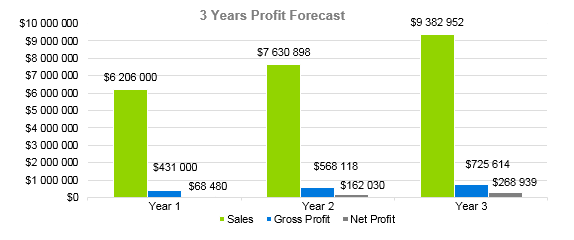
Company Summary
3.1 Company Owner
Marlon Redford will be the owner of Marlon Caterers. Marlon has acquired a degree in Business Administration from McDonough School of Business. Marlon has been serving on a managerial post in New York’s top luxury wedding planner company, Colin Cowie for four years. But a few months back, he decided to quit the job and start his own business.
3.2 Why the Business is being started
Marlon always wanted to have a career in which he could utilize his creative ideas to serve his community. He loved food and had an interest in cooking as well. So he decided to make a small team and start a business plans for catering companies.
3.3 How the Business will be started
The first step before starting a catering business is creating a description of catering business plan. Your catering company business plan should cover all aspects such as startup expenses, market analysis, sales strategy, personnel plan, and an extensive financial plan for your business.
In this catering company business plan example, we have listed the business strategy created by Marlon Caterers. Marlon devised his start a catering company business plan himself as he had adequate knowledge to do so. If you don’t know how to write a business plans for catering companies, you should either take help from this sample business plan for catering service. Or you should hire a professional person.
Marlon will rent a facility in Atlanta to set up his office there and keep the inventory. He will purchase luxurious crockery, flatware, tableware, chairs, tables, and sofas to host high-end events. To serve the other categories of target customers, inventory that comes in reasonable rates will also be acquired.
Besides, Marlon will hire the general staff, chefs, waiters, and some supervisors to help him run the business.
The start-up requirements, start-up expenses, total assets, funding, liabilities, planned investment, and other parameters for the successful launch of the business are given below.
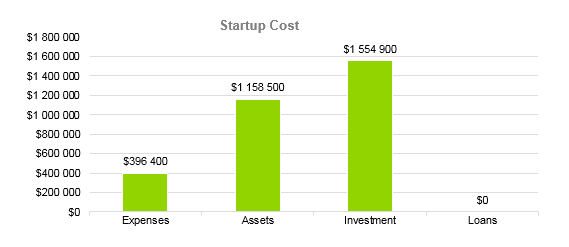
| Start-up Expenses | |
| Legal | $251,000 |
| Consultants | $0 |
| Insurance | $30,000 |
| Rent | $28,000 |
| Research and Development | $25,000 |
| Expensed Equipment | $57,000 |
| Signs | $5,400 |
| TOTAL START-UP EXPENSES | $396,400 |
| Start-up Assets | $317,500 |
| Cash Required | $348,000 |
| Start-up Inventory | $55,000 |
| Other Current Assets | $211,000 |
| Long-term Assets | $227,000 |
| TOTAL ASSETS | $1,158,500 |
| Total Requirements | $1,554,900 |
| START-UP FUNDING | |
| Start-up Expenses to Fund | $396,400 |
| Start-up Assets to Fund | $1,158,500 |
| TOTAL FUNDING REQUIRED | $1,554,900 |
| Assets | |
| Non-cash Assets from Start-up | $1,531,000 |
| Cash Requirements from Start-up | $364,000 |
| Additional Cash Raised | $54,000 |
| Cash Balance on Starting Date | $32,000 |
| TOTAL ASSETS | $1,981,000 |
| Liabilities and Capital | |
| Liabilities | $28,000 |
| Current Borrowing | $0 |
| Long-term Liabilities | $0 |
| Accounts Payable (Outstanding Bills) | $46,000 |
| Other Current Liabilities (interest-free) | $0 |
| TOTAL LIABILITIES | $74,000 |
| Capital | |
| Planned Investment | $1,554,900 |
| Investor 1 | $0 |
| Investor 2 | $0 |
| Other | $0 |
| Additional Investment Requirement | $0 |
| TOTAL PLANNED INVESTMENT | $1,554,900 |
| Loss at Start-up (Start-up Expenses) | $352,100 |
| TOTAL CAPITAL | $1,907,000 |
| TOTAL CAPITAL AND LIABILITIES | $1,981,000 |
| Total Funding | $1,554,900 |
Services
Before you start a business plans for catering companies, you must identify the services you can provide under the catering domain. Including your services in your business plan about catering, can help you in acquiring the right licenses, required inventory, and relevant staff.
In this template of a catering business plan we are enlisting the services provided by Marlon Caterers.
We’ll offer on-premise and off-premise catering in the following categories.
- Plated Sit-down catering
In this catering, our waiters will lay out the food on individual tables. So, the guests will have to eat whatever is laid out on the plates for them.
- Buffet Catering
In this type of serving we will serve the dishes and food in one place. The guests will have to prepare their plates themselves according to their needs and wants.
- Cocktail Reception
Our wedding or party dinner will be preceded by a cocktail hour. Our cocktail servings will include Manhattan cocktail, Daiquiri, Margarita, Bloody Mary, Mojito, and Hurricane.
- Snacks & Drinks For Production Sets
We will supply food, snacks, and drinks to film studios, production sets, and shooting sites located near us. As the film crew works on a particular site on a weekly or monthly basis, so we’ll offer them various weekly and monthly packages.
- Hospital Catering
We’ll offer fresh, healthy, and nutritious foods to hospitals for patients. Our nutrient-rich meals will help them recover fast.
Marketing Analysis of Catering Business
If you are starting a business plan for catering companies, you should focus on doing accurate marketing analysis. Through market research, you can identify local trends and expectations. Besides, you can also select the most suitable location to launch your startup.
Note
Marketing analysis should be completed before you create a business plans for catering companies. Because it will help you in recognizing your customers and setting your prices accordingly while also making sure that you are not running at a loss.
excellent work
excellent work, competent advice.
Alex is very friendly, great communication.
100% I recommend CGS capital.
Thank you so much for your hard work!
5.1 Market Trends
The demand for the catering business has been high in the last few years. Due to a boost in average household income, more people had started utilizing private catering services to hold events. However, there is a slight problem these days. Due to the coronavirus pandemic mass gatherings aren’t allowed. So, your business might suffer a loss in the initial phases if you only provide catering for wedding ceremonies and parties. Marlon found the solution to this problem as he decided to offer hospital and film catering too.
Overall, business is surely profitable. According to First Research, catering industries in the U.S. make up above $11 billion in revenue on annual basis. More than 12000 catering industries are running in the U.S. Moreover, Statista also reports that the market size of this business has reached $12 billion in 2020.
5.2 Marketing Segmentation
Before you think how to write a business plan for a catering business, you should consider who will be your customers. Knowing your customers will enable you to devise customer-oriented pricing and sales strategy.
In this sample of business plans for catering companies, we have listed the market segmentation done by Marlon Caterers.
The detailed marketing segmentation of our target audience is as follows:
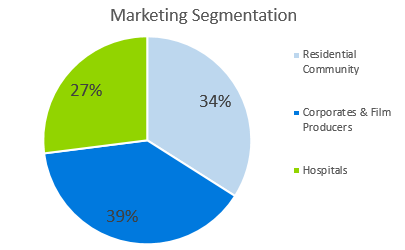
Business Plan for Investors
5.1.1 Residential Community
The biggest consumer of our services will be the residents of Atlanta. They are expected to avail of our catering services whenever they host birthday or anniversary parties, gatherings, wedding ceremonies, etc.
5.1.2 Corporates & Film Producers
The second category includes business organizations that will need our catering for their business meetups, events, and parties. They are also expected to contact us for arranging just a cocktail party as that contains light refreshments and drinks to boost the energy level of workers.
Moreover, film studios that happen to shoot in Atlanta will also be needing our services. This group usually spent weeks and months on a particular site and thus need catering service continuously for days. So to compel them to hire us, we’ll offer them various weekly and monthly packages.
5.1.3 Hospitals
The last category of our target customers include hospitals based in Atlanta. They are expected to contact us for making nutritious and healthy plated foods for patients.
| Market Analysis | |||||||
| Potential Customers | Growth | Year 1 | Year 2 | Year 3 | Year 4 | Year 5 | CAGR |
| Residential Community | 34% | 34,000 | 35,000 | 38,000 | 40,000 | 43,000 | 10.00% |
| Corporates & Film Producers | 39% | 37,000 | 38,000 | 39,000 | 40,000 | 41,000 | 10.00% |
| Hospitals | 27% | 26,000 | 27,000 | 28,000 | 30,000 | 31,000 | 11.00% |
| Total | 100% | 97,000 | 100,000 | 105,000 | 110,000 | 115,000 | 10% |
5.3 Business Target
Our business plans for catering companies targets to be achieved within a specified time are listed below
- To achieve a net profit margin of $22k per month by the end of the third year
- To maintain an average rating above 4.75 on our website
- To reduce our customer acquisition cost by 20% by the end of five years
- To keep our customer churn rate below 5% throughout our service years
5.4 Product Pricing
Our prices are almost within the same range as that of our competitors. However, we’ll be offering several discounts on our initial stage to attract as many customers as possible.
Marketing Strategy
Sales strategy is also an important component of a catering business plan proposal. Through this, you can reach your qualified customers and make them comprehend that you are better than all your competitors. To give you an idea of what to include in sales strategy, we are providing the sales strategy of Marlon Caterers in this example of marketing plan for a catering business.
6.1 Competitive Analysis
Our biggest competitive advantage lies in our customer service. We are highly customer-oriented and are always willing to go the extra mile to satisfy our customers. Secondly, we have developed a user-friendly mobile app that will allow our customers to
- Make online bookings
- Choose venue
- Select dishes from our menu
Third, we provide on-premise catering in which we prepare the food on site. This will be a competitive edge for us as just two to three competitors are offering it.
6.2 Sales Strategy
- We will offer a 35% discount on our services for the first month of the launch
- We will develop an SEO website to show our business in the top results on searches
- We will establish a strong social media presence
- We will advertise ourselves through Google Local ads service, local magazines, and newspapers
6.3 Sales Monthly
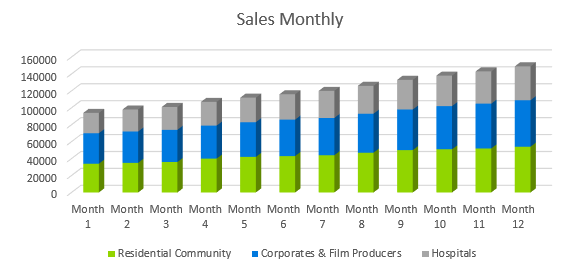
6.4 Sales Yearly
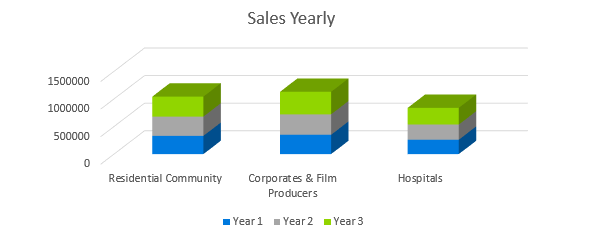
6.5 Sales Forecast
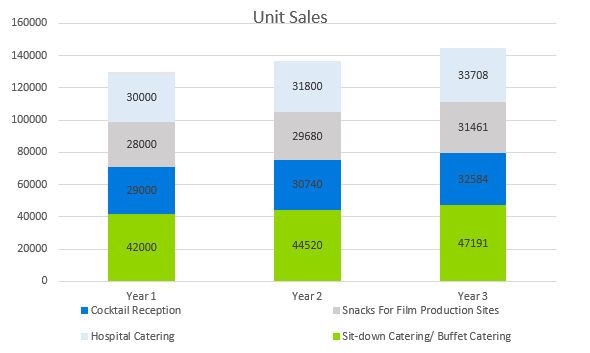
| Sales Forecast | |||
| Unit Sales | Year 1 | Year 2 | Year 3 |
| Sit-down Catering/ Buffet Catering | 42,000 | 44,520 | 47,191 |
| Cocktail Reception | 29,000 | 30,740 | 32,584 |
| Snacks For Film Production Sites | 28,000 | 29,680 | 31,461 |
| Hospital Catering | 30,000 | 31,800 | 33,708 |
| TOTAL UNIT SALES | 129,000 | 136,740 | 144,944 |
| Unit Prices | Year 1 | Year 2 | Year 3 |
| Sit-down Catering/ Buffet Catering | $56.00 | $64.96 | $75.35 |
| Cocktail Reception | $52.00 | $60.32 | $69.97 |
| Snacks For Film Production Sites | $42.00 | $48.72 | $56.52 |
| Hospital Catering | $39.00 | $45.24 | $52.48 |
| Sales | |||
| Sit-down Catering/ Buffet Catering | $2,352,000.00 | $2,892,019.20 | $3,556,026.81 |
| Cocktail Reception | $1,508,000.00 | $1,854,236.80 | $2,279,969.57 |
| Snacks For Film Production Sites | $1,176,000.00 | $1,446,009.60 | $1,778,013.40 |
| Hospital Catering | $1,170,000.00 | $1,438,632.00 | $1,768,941.91 |
| TOTAL SALES | $6,206,000.00 | $7,630,897.60 | $9,382,951.69 |
| Direct Unit Costs | Year 1 | Year 2 | Year 3 |
| Sit-down Catering/ Buffet Catering | $54.00 | $60.00 | $71.00 |
| Cocktail Reception | $47.00 | $57.00 | $65.00 |
| Snacks For Film Production Sites | $38.00 | $45.00 | $51.00 |
| Hospital Catering | $36.00 | $41.00 | $47.00 |
| Direct Cost of Sales | |||
| Sit-down Catering/ Buffet Catering | $2,268,000.00 | $2,671,200.00 | $3,350,575.20 |
| Cocktail Reception | $1,363,000.00 | $1,752,180.00 | $2,117,986.00 |
| Snacks For Film Production Sites | $1,064,000.00 | $1,335,600.00 | $1,604,500.80 |
| Hospital Catering | $1,080,000.00 | $1,303,800.00 | $1,584,276.00 |
| Subtotal Direct Cost of Sales | $5,775,000.00 | $7,062,780.00 | $8,657,338.00 |
Personnel plan
While writing business plans for catering companies you should also create a list of your required employees along with their job responsibilities.
7.1 Company Staff
Marlon will manage the business himself. However, he will hire the following people
- 1 Quality Manager to ensure the quality of service by active supervision
- 1 Inventory Manager to manage and maintain the merchandise
- 1 Accountant to maintain financial records
- 2 Sales Executives to market and to discover new ventures
- 5 Catering Assistants/ Catering Chefs to prepare the food
- 4 Waiters to serve the guests
- 2 General Assistants to bring ingredients daily
- 1 Web Developer
- 2 Drivers to provide transport
- 1 Front Desk Officer to act as a receptionist
7.2 Average Salary of Employees
| Personnel Plan | |||
| Year 1 | Year 2 | Year 3 | |
| Quality Manager | $13,000 | $14,300 | $15,730 |
| Inventory Manager | $12,000 | $13,200 | $14,520 |
| Accountant | $10,000 | $11,000 | $12,100 |
| Sales Executives | $18,000 | $19,800 | $21,780 |
| Catering Chefs | $48,000 | $52,800 | $58,080 |
| Waiters | $24,000 | $26,400 | $29,040 |
| General Assistants | $15,000 | $16,500 | $18,150 |
| Drivers | $13,000 | $14,300 | $15,730 |
| Front Desk Officer | $7,000 | $7,700 | $8,470 |
| Web Developer | $8,000 | $8,800 | $9,680 |
| Total Salaries | $168,000 | $184,800 | $203,280 |
Financial Plan
As you make a catering business plan, you should also start analyzing your finances. Crafting a financial plan is an absolute need for a business as it maps the ways to minimize or even avoid loss. A good financial plan comprises a strategy to cover startup expenses with earned profits. Moreover, it also proposes a systematic approach to managing employees’ salaries, cost of business operations, and costs to cater for unexpected events.
To give you an idea of how a financial plan should look like, we are giving here the financial plan of Marlon Caterers.
8.1 Important Assumptions
| General Assumptions | |||
| Year 1 | Year 2 | Year 3 | |
| Plan Month | 1 | 2 | 3 |
| Current Interest Rate | 8.13% | 8.18% | 8.25% |
| Long-term Interest Rate | 8.30% | 8.39% | 8.46% |
| Tax Rate | 23.05% | 24.67% | 25.90% |
| Other | 0 | 0 | 0 |
8.2 Brake-even Analysis
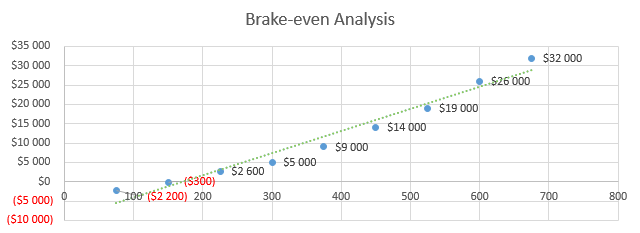
| Brake-Even Analysis | |
| Monthly Units Break-even | 5360 |
| Monthly Revenue Break-even | $134,800 |
| Assumptions: | |
| Average Per-Unit Revenue | $239.00 |
| Average Per-Unit Variable Cost | $0.64 |
| Estimated Monthly Fixed Cost | $162,300 |
8.3 Projected Profit and Loss
| Pro Forma Profit And Loss | |||
| Year 1 | Year 2 | Year 3 | |
| Sales | $6,206,000 | $7,630,898 | $9,382,952 |
| Direct Cost of Sales | $5,775,000 | $7,062,780 | $8,657,338 |
| Other | $0 | $0 | $0 |
| TOTAL COST OF SALES | $5,775,000 | $7,062,780 | $8,657,338 |
| Gross Margin | $431,000 | $568,118 | $725,614 |
| Gross Margin % | 6.94% | 7.44% | 7.73% |
| Expenses | |||
| Payroll | $168,000 | $184,800 | $203,280 |
| Sales and Marketing and Other Expenses | $130,000 | $132,000 | $135,000 |
| Depreciation | $2,200 | $2,280 | $2,350 |
| Leased Equipment | $0 | $0 | $0 |
| Utilities | $3,200 | $3,300 | $3,400 |
| Insurance | $1,700 | $1,800 | $1,900 |
| Rent | $3,300 | $3,400 | $3,510 |
| Payroll Taxes | $37,000 | $38,000 | $40,000 |
| Other | $0 | $0 | $0 |
| Total Operating Expenses | $345,400 | $365,580 | $389,440 |
| Profit Before Interest and Taxes | $85,600 | $202,538 | $336,174 |
| EBITDA | $85,600 | $202,538 | $336,174 |
| Interest Expense | $0 | $0 | $0 |
| Taxes Incurred | $17,120 | $40,508 | $67,235 |
| Net Profit | $68,480 | $162,030 | $268,939 |
| Net Profit/Sales | 1.10% | 2.12% | 2.87% |
8.3.1 Profit Monthly
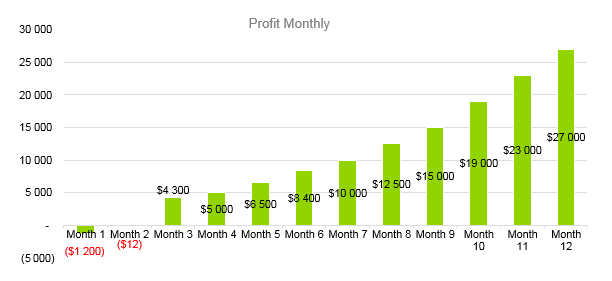
8.3.2 Profit Yearly
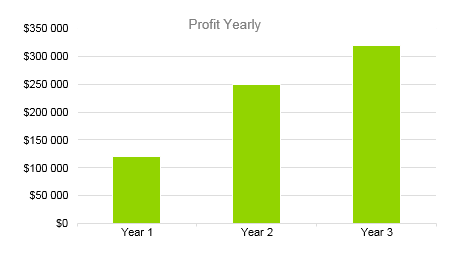
8.3.3 Gross Margin Monthly
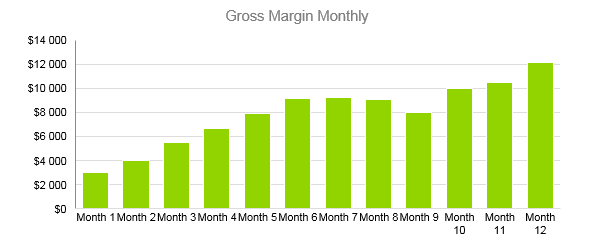
8.3.4 Gross Margin Yearly
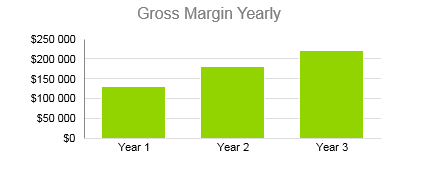
8.4 Projected Cash Flow
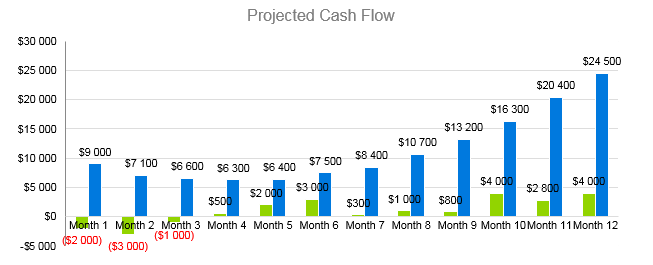
| Pro Forma Cash Flow | |||
| Cash Received | Year 1 | Year 2 | Year 3 |
| Cash from Operations | |||
| Cash Sales | $56,000 | $60,480 | $65,318 |
| Cash from Receivables | $17,000 | $18,360 | $19,829 |
| SUBTOTAL CASH FROM OPERATIONS | $73,000 | $79,570 | $85,936 |
| Additional Cash Received | |||
| Sales Tax, VAT, HST/GST Received | $0 | $0 | $0 |
| New Current Borrowing | $0 | $0 | $0 |
| New Other Liabilities (interest-free) | $0 | $0 | $0 |
| New Long-term Liabilities | $0 | $0 | $0 |
| Sales of Other Current Assets | $0 | $0 | $0 |
| Sales of Long-term Assets | $0 | $0 | $0 |
| New Investment Received | $0 | $0 | $0 |
| SUBTOTAL CASH RECEIVED | $73,000 | $79,000 | $86,000 |
| Expenditures | Year 1 | Year 2 | Year 3 |
| Expenditures from Operations | |||
| Cash Spending | $35,000 | $37,000 | $39,000 |
| Bill Payments | $19,000 | $19,600 | $20,000 |
| SUBTOTAL SPENT ON OPERATIONS | $56,000 | $57,300 | $61,000 |
| Additional Cash Spent | |||
| Sales Tax, VAT, HST/GST Paid Out | $0 | $0 | $0 |
| Principal Repayment of Current Borrowing | $0 | $0 | $0 |
| Other Liabilities Principal Repayment | $0 | $0 | $0 |
| Long-term Liabilities Principal Repayment | $0 | $0 | $0 |
| Purchase Other Current Assets | $0 | $0 | $0 |
| Purchase Long-term Assets | $0 | $0 | $0 |
| Dividends | $0 | $0 | $0 |
| SUBTOTAL CASH SPENT | $57,000 | $61,560 | $66,485 |
| Net Cash Flow | $14,000 | $15,000 | $16,000 |
| Cash Balance | $24,000 | $25,400 | $27,800 |
8.5 Projected Balance Sheet
| Pro Forma Balance Sheet | |||
| Assets | Year 1 | Year 2 | Year 3 |
| Current Assets | |||
| Cash | $279,000 | $312,480 | $343,728 |
| Accounts Receivable | $25,000 | $28,000 | $31,472 |
| Inventory | $5,300 | $5,936 | $6,678 |
| Other Current Assets | $1,000 | $1,000 | $1,000 |
| TOTAL CURRENT ASSETS | $294,000 | $329,280 | $370,111 |
| Long-term Assets | |||
| Long-term Assets | $10,000 | $10,000 | $10,000 |
| Accumulated Depreciation | $18,700 | $20,944 | $23,562 |
| TOTAL LONG-TERM ASSETS | $23,000 | $25,760 | $28,980 |
| TOTAL ASSETS | $293,000 | $328,160 | $369,180 |
| Liabilities and Capital | Year 4 | Year 5 | Year 6 |
| Current Liabilities | |||
| Accounts Payable | $18,000 | $20,160 | $22,660 |
| Current Borrowing | $0 | $0 | $0 |
| Other Current Liabilities | $0 | $0 | $0 |
| SUBTOTAL CURRENT LIABILITIES | $13,400 | $15,008 | $16,869 |
| Long-term Liabilities | $0 | $0 | $0 |
| TOTAL LIABILITIES | $13,800 | $15,456 | $17,373 |
| Paid-in Capital | $30,000 | $30,000 | $30,000 |
| Retained Earnings | $56,300 | $61,367 | $67,504 |
| Earnings | $195,000 | $212,550 | $233,805 |
| TOTAL CAPITAL | $275,000 | $299,750 | $329,725 |
| TOTAL LIABILITIES AND CAPITAL | $288,800 | $328,160 | $369,180 |
| Net Worth | $268,000 | $292,120 | $321,332 |
8.6 Business Ratios
| Ratio Analysis | ||||
| Year 1 | Year 2 | Year 3 | INDUSTRY PROFILE | |
| Sales Growth | 7.31% | 8.10% | 8.97% | 3.00% |
| Percent of Total Assets | ||||
| Accounts Receivable | 9.35% | 10.36% | 11.48% | 9.80% |
| Inventory | 5.38% | 5.96% | 6.60% | 9.90% |
| Other Current Assets | 2.43% | 2.69% | 2.98% | 2.40% |
| Total Current Assets | 150.00% | 152.00% | 152.00% | 158.00% |
| Long-term Assets | 11.98% | 12.07% | 12.10% | 12.00% |
| TOTAL ASSETS | 100.00% | 100.00% | 100.00% | 100.00% |
| Current Liabilities | 4.66% | 4.70% | 4.74% | 4.34% |
| Long-term Liabilities | 0.00% | 0.00% | 0.00% | 0.00% |
| Total Liabilities | 7.31% | 7.37% | 7.44% | 7.38% |
| NET WORTH | 102.03% | 102.85% | 103.79% | 110.00% |
| Percent of Sales | ||||
| Sales | 100.00% | 100.00% | 100.00% | 100.00% |
| Gross Margin | 93.90% | 96.44% | 99.14% | 99.00% |
| Selling, General & Administrative Expenses | 93.20% | 95.72% | 98.40% | 97.80% |
| Advertising Expenses | 1.60% | 1.64% | 1.69% | 1.40% |
| Profit Before Interest and Taxes | 42.00% | 43.13% | 44.34% | 33.90% |
| Main Ratios | ||||
| Current | 35 | 37 | 38.75 | 32 |
| Quick | 33 | 36 | 36.9 | 33 |
| Total Debt to Total Assets | 0.22% | 0.18% | 0.17% | 0.40% |
| Pre-tax Return on Net Worth | 76.00% | 76.40% | 77.12% | 75.00% |
| Pre-tax Return on Assets | 92.18% | 96.79% | 101.63% | 111.30% |
| Additional Ratios | Year 1 | Year 2 | Year 3 | |
| Net Profit Margin | 33.40% | 34.44% | 35.50% | N.A. |
| Return on Equity | 55.20% | 56.91% | 58.68% | N.A. |
| Activity Ratios | ||||
| Accounts Receivable Turnover | 7.7 | 7.8 | 7.9 | N.A. |
| Collection Days | 100 | 100 | 100 | N.A. |
| Inventory Turnover | 32 | 33.6 | 35.28 | N.A. |
| Accounts Payable Turnover | 16.3 | 16.4 | 16.6 | N.A. |
| Payment Days | 27 | 27 | 27 | N.A. |
| Total Asset Turnover | 2.5 | 2.6 | 2.7 | N.A. |
| Debt Ratios | ||||
| Debt to Net Worth | -0.03 | -0.04 | -0.04 | N.A. |
| Current Liab. to Liab. | 1 | 1 | 1 | N.A. |
| Liquidity Ratios | ||||
| Net Working Capital | $237,650 | $250,958 | $265,012 | N.A. |
| Interest Coverage | 0 | 0 | 0 | N.A. |
| Additional Ratios | ||||
| Assets to Sales | 0.85 | 0.87 | 0.89 | N.A. |
| Current Debt/Total Assets | 1% | 1% | 0% | N.A. |
| Acid Test | 28 | 29.1 | 30.5 | N.A. |
| Sales/Net Worth | 2.1 | 2.2 | 2.4 | N.A. |
| Dividend Payout | 0 | 0 | 0 | N.A. |
Download Catering Company Business Plan Sample in pdf
OGScapital also specializes in writing business plans such as starting coffee roasting business plan, brewery startup business plan, confectionery shop business plan, bakery business idea, cookie business plan, bed and breakfast business plan and etc.




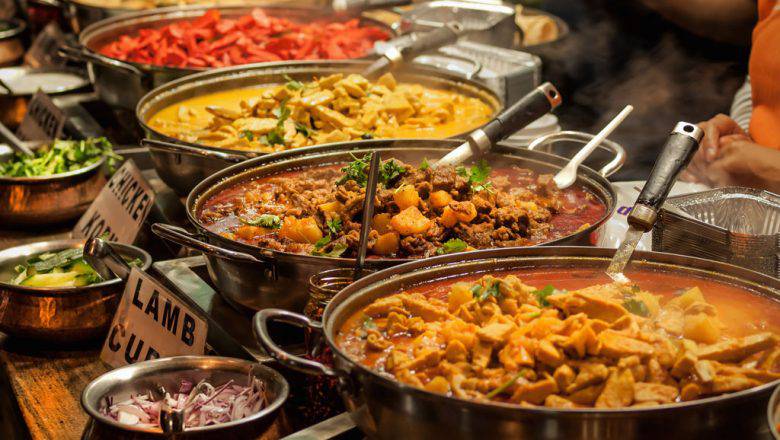





Add comment
Comments (0)